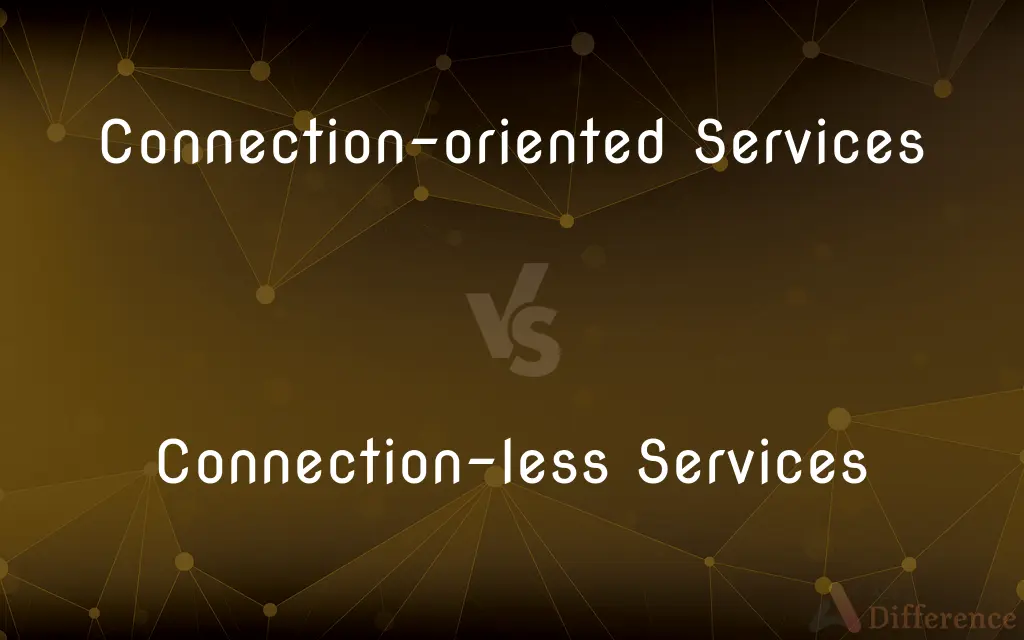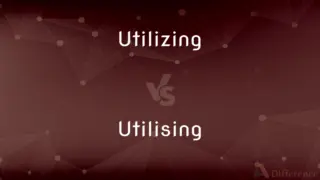Connection-oriented Services vs. Connection-less Services — What's the Difference?
By Tayyaba Rehman — Published on January 3, 2024
Connection-oriented services establish a dedicated connection before data transmission, ensuring reliable delivery. Connection-less services send data without establishing a connection, prioritizing speed over reliability.

Difference Between Connection-oriented Services and Connection-less Services
Table of Contents
ADVERTISEMENT
Key Differences
Connection-oriented Services require a predefined path and a session establishment before data packets can be sent. This setup ensures a reliable, ordered, and error-checked delivery of data. In contrast, Connection-less Services do not establish a fixed path or session; instead, they send data packets individually, which may take different routes, leading to faster but less reliable transmission.
In Connection-oriented Services, data integrity and delivery are guaranteed, making them suitable for applications where reliability is crucial, like file transfers and streaming media. Connection-less Services are more suitable for applications where speed and efficiency are more important than reliability, such as online gaming or voice over IP (VoIP).
Error handling and flow control are integral parts of Connection-oriented Services, as they continuously monitor the data transfer for any issues and adjust accordingly. However, in Connection-less Services, error handling and flow control are typically managed by the application layer, if at all, which can lead to data loss or duplication.
A typical example of a Connection-oriented Service is Transmission Control Protocol (TCP), widely used in the internet protocol suite. On the other hand, User Datagram Protocol (UDP) exemplifies Connection-less Services, offering faster data transmission at the cost of reliability.
Connection-oriented Services often have higher overhead due to the need for connection establishment, maintenance, and teardown, making them slower in some scenarios. Conversely, Connection-less Services have lower overhead, providing quicker data transmission but with a risk of packet loss and no guaranteed order of delivery.
ADVERTISEMENT
Comparison Chart
Connection Establishment
Required before data transfer
No prior connection needed
Reliability
High, with guaranteed delivery
Lower, with possible data loss
Use Cases
File transfers, streaming media
Online gaming, VoIP
Error Handling
Integral part of the service
Managed by the application or not at all
Protocol Example
Transmission Control Protocol (TCP)
User Datagram Protocol (UDP)
Compare with Definitions
Connection-oriented Services
Requires a connection before transmitting data.
Banking apps use connection-oriented services for secure transactions.
Connection-less Services
Sends data without establishing a connection.
Online games use connection-less services for faster response times.
Connection-oriented Services
Higher overhead due to connection management.
Despite higher overhead, connection-oriented services provide essential data reliability.
Connection-less Services
Prone to data loss and duplication.
Streaming live events might use connection-less services, accepting some data loss.
Connection-oriented Services
Ensures data integrity and order.
Streaming services rely on connection-oriented protocols for smooth playback.
Connection-less Services
Does not guarantee data delivery or order.
Connection-less protocols may result in out-of-order packet delivery.
Connection-oriented Services
Involves a three-way handshake process.
TCP's three-way handshake is key to connection-oriented communication.
Connection-less Services
Lower overhead compared to connection-oriented.
Connection-less services are efficient due to their reduced protocol overhead.
Connection-oriented Services
Suitable for applications needing reliable data transfer.
Email protocols often utilize connection-oriented services for reliability.
Connection-less Services
Suitable for applications where speed is critical.
Voice over IP applications often prefer connection-less services for efficiency.
Common Curiosities
What are Connection-less Services?
Services that transmit data without prior connection establishment.
Where are Connection-less Services more applicable?
In scenarios where speed is more critical than reliability, like in online gaming.
Can Connection-oriented Services handle real-time applications efficiently?
While reliable, they may have latency issues compared to connection-less services.
Is TCP connection-oriented?
Yes, TCP is a connection-oriented protocol.
What are Connection-oriented Services?
These are network services that require establishing a connection before transmitting data.
Why choose Connection-oriented over Connection-less?
Choose Connection-oriented for applications requiring reliable data delivery, like file transfer.
What is the main disadvantage of Connection-oriented Services?
Their main disadvantage is the higher overhead associated with establishing and maintaining connections.
Is UDP connection-less?
Yes, UDP is a connection-less protocol.
Are Connection-less Services less secure?
They can be, as they lack the inherent reliability checks of connection-oriented services.
Which service is faster, Connection-oriented or Connection-less?
Generally, Connection-less services are faster due to less overhead.
Which service type is better for streaming video?
Connection-oriented services are usually better for streaming video due to their reliability.
Do Connection-oriented Services guarantee error-free transmission?
They have mechanisms for error-checking, but absolute error-free transmission is not guaranteed.
Do Connection-oriented Services maintain the order of data packets?
Yes, they maintain the order of data packets.
How do Connection-less Services manage data loss?
Typically, they don't manage data loss; it's usually handled by higher-level applications.
Can I use both types of services in one application?
Yes, some applications use both for different aspects of their communication needs.
Share Your Discovery

Previous Comparison
For in PHP vs. Foreach in PHP
Next Comparison
Utilizing vs. UtilisingAuthor Spotlight
Written by
Tayyaba RehmanTayyaba Rehman is a distinguished writer, currently serving as a primary contributor to askdifference.com. As a researcher in semantics and etymology, Tayyaba's passion for the complexity of languages and their distinctions has found a perfect home on the platform. Tayyaba delves into the intricacies of language, distinguishing between commonly confused words and phrases, thereby providing clarity for readers worldwide.
















































